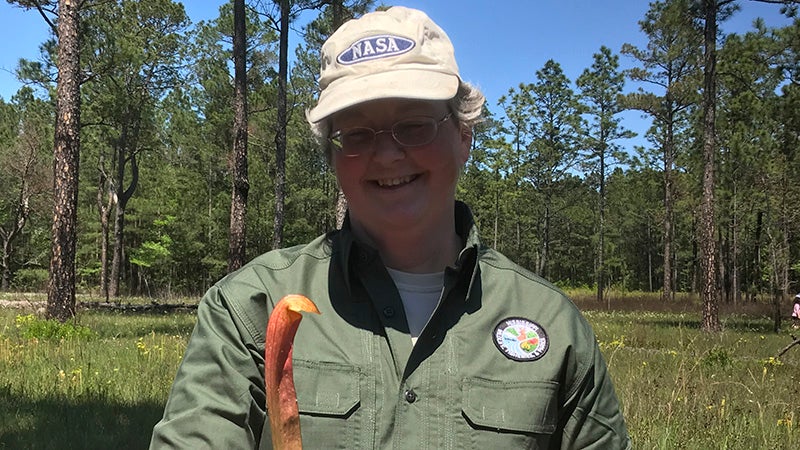Arboretum Paths: Carnivorous plant species in the bog!
Published 7:00 am Wednesday, April 12, 2017

- State botanist Heather Sullivan holds an unusual hybrid pitcher plant, the result of two parent species having "crossed" in the Arboretum's south bog (Photo by Pat Drackett)
By Pat Drackett, Director, The Crosby Arboretum
MSU Extension Service
Last Saturday’s field walks were very well-attended. It’s always a pleasure to see so many people seeking to learn more about our Mississippi native flora!
In addition to the topics of ferns and blooming plant species, a walk focused on carnivorous species found in our Savanna Exhibit.
State botanist Heather Sullivan, from the Mississippi Department of Wildlife, Fisheries and Parks, who led the morning program, joined us for the afternoon walk. Her thorough knowledge of Mississippi’s native plant species made our bog tour even more information-packed.
Bogs and wet pine savannas are ecosystems with a very rich plant diversity. This means you can spend a lot of time looking over the many species occurring in one small area.
Carnivorous plants obtain additional nitrogen in the bogs’ acidic, nutrient-poor soils through various methods of trapping and digesting insects. Some, like the pitcher plants, have hollow leaves that insects tumble into, enticed by the scent of sweet nectar. Heather demonstrated how these tubular leaves have a center midrib just like a regular leaf, modified into a “pitcher” shape.
The tops of the pitcher plants are hooded. This keeps the rain from diluting the digestive juices, and provides an environment where some insect species can dwell unharmed. Bog insects will also take shelter in the complex flowers.
Heather dissected a flower, revealing the ovary at the center. Inside the ovary are ovules that, if fertilized, become seeds. Attached to the ovary is an umbrella-shaped structure called a “style” containing the pollen tubes which assist with plant fertilization. She removed the style and showed us what a perfect little “apartment” the structure offers for bog insects. Here, they “hang out”, becoming covered in pollen.
Use your favorite Internet search engine to locate an illustration of the parts of a pitcher plant flower. What I find interesting is that the petals of the flower are present for only a few weeks in the spring – and look like long dangling “curtains”. In the yellow pitcher plants (Sarracenia alata), the petals are a delicate light yellow color. But the sepals, which resemble petals, will remain the rest of the year.
A second species of pitcher plant found in the bog is the parrot pitcher plant (Sarracenia psittacina). It blooms later than the yellow pitcher plant and has attractive maroon flowers. These are very short plants, six inches at most.
Unlike yellow pitcher plants, which attract flying insects, parrot pitchers have tiny openings which lure small terrestrial insects, such as ants.
Although the two species bloom at separate times, occasionally they cross-pollinate and produce a hybrid. Several years ago board member Julia Anderson noticed a cluster of pitcher plants with an unusual coloration. She took a photo, showing it was unlike either of the two species. We suspected we had a hybrid residing in the bog!
Who better than Heather to have on hand to settle this question? She retrieved a leaf of the flower and pronounced the plant was indeed a hybrid, having characteristics of both parent species. She added that the plant was most likely sterile, however, just like a mule.
We also discussed two species of sundews. The tiny rosettes of dwarf sundew (Drosera brevifolia), grow tightly against the bog’s bare soil, and are covered in sparkling ruby “dew”. Heather pointed out they are about to bloom! Tiny threadlike stems will soon be topped by large white flowers. Look closely along the edges of the bog pathways, to see these blooms unfolding over the next few weeks.
Heather also pointed out an uncommon species called threadleaf sundew (Drosera tracyi). This gossamer mass of upright thin leaves is about a foot tall, and covered with drops of sticky dew (and stuck insects!).
We also encountered several tiny terrestrial bladderworts (Utricularia) with yellow flowers. Aquatic bladderworts also occur at the Arboretum. These carnivorous plants actively trap nematodes, protozoa and other microorganisms, and make for very interesting reading (or Internet video-viewing!).
Attend a yoga program with certified instructor Jim Sones at 10 AM on April 22, on the Pinecote Pavilion. For more information, see www.crosbyarboretum.msstate.edu. Call 601-799-2311 to sign up. The Arboretum is located in Picayune, I-59 Exit 4, at 370 Ridge Road (south of Walmart and adjacent to I-59).



